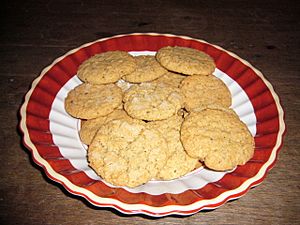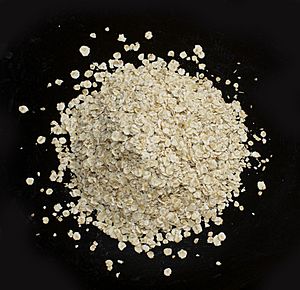Oatmeal facts for kids
|
Rolled oats, a type of oatmeal
|
|
| Alternative names | White oats |
|---|---|
| Type | Porridge |
| Main ingredients | Oat groats |
Oatmeal is a popular food made from oat grains. It's basically a coarse flour or flakes from oats that have had their outer shell removed.
There are different kinds of oatmeal:
- Ground oats are also called "white oats."
- Steel-cut oats are chopped into small pieces. They are sometimes called "Irish oatmeal."
- Rolled oats are steamed and flattened. They can be "thick," "quick," or "instant."
In places like the U.S. and Canada, "oatmeal" also means the warm, creamy porridge you eat for breakfast. This porridge can be made from any of these oat types.

Contents
How Is Oatmeal Made?
To make oatmeal, oat grains first have their tough outer husks removed. This is done by hitting them gently. After that, the oats are heated and then cooled. This process helps to make the oats stable and gives them a nice nutty flavor.
These prepared oat grains, called groats, can then be processed in different ways:
- Milled oatmeal is made by grinding the groats into a fine, medium, or coarse powder.
- Steel-cut oats are groats that are simply cut into two or three smaller pieces.
- Rolled oats are made by steaming whole oat groats and then flattening them.
Types of Rolled Oats
There are a few kinds of rolled oats you might see:
- Old-fashioned oats are thick. They take a bit longer to cook into porridge.
- Quick oats are cut into smaller pieces before being steamed and rolled. This makes them cook faster.
- Instant oatmeal is already cooked and dried. It often has sugar and flavors added. You just add hot water, and it's ready!
Eating Oatmeal: Many Ways to Enjoy It
| Nutritional value per 100 g (3.5 oz) | |
|---|---|
| Energy | 297 kJ (71 kcal) |
|
12 g
|
|
| Sugars | 0.3 |
| Dietary fiber | 1.7 g |
|
1.5 g
|
|
|
Protein
|
2.5 g
|
| Vitamins | Quantity
%DV†
|
| Vitamin A equiv. |
0%
0 μg |
| Thiamine (B1) |
7%
0.08 mg |
| Riboflavin (B2) |
2%
0.02 mg |
| Niacin (B3) |
1%
0.23 mg |
| Pantothenic acid (B5) |
4%
0.197 mg |
| Vitamin B6 |
0%
0.005 mg |
| Folate (B9) |
2%
6 μg |
| Vitamin C |
0%
0 mg |
| Vitamin E |
1%
0.08 mg |
| Vitamin K |
0%
0.3 μg |
| Minerals | Quantity
%DV†
|
| Calcium |
1%
9 mg |
| Iron |
7%
0.9 mg |
| Magnesium |
8%
27 mg |
| Manganese |
29%
0.6 mg |
| Phosphorus |
11%
77 mg |
| Potassium |
2%
70 mg |
| Sodium |
0%
4 mg |
| Zinc |
11%
1 mg |
| Other constituents | Quantity |
| Water | 83.6 |
|
Link to USDA Database entry
|
|
| †Percentages estimated using US recommendations for adults. | |
You can eat rolled oats uncooked, like in muesli, which is a mix of oats, nuts, and fruit. Or, you can cook them with water or milk to make a warm porridge. Some people like to eat raw or toasted oats with milk and sugar, sometimes adding raisins.
Oatmeal is also a key ingredient in many other foods:
- Breakfast cereals like granola, where oats are toasted with sugar, nuts, and raisins.
- Snack bars like granola bars.
- Baked goods such as oatmeal cookies, oatcakes, and British flapjack bars.
- Desserts like apple crisp.
Oats can also be added to foods for texture or nutrition. They are used as a topping on some breads and as a coating for Caboc cheese. In some soups, oatmeal helps to make them thicker. It can also add healthy fiber to dishes like meatloaf.
Oatmeal and Your Health
Oatmeal is very healthy! When cooked with water, it's mostly water (84%). It also has carbohydrates (12%), including dietary fiber (2%), and small amounts of protein and fat (2% each).
A 100-gram serving of cooked oatmeal gives you about 71 Calories. It's a good source of manganese and has some phosphorus and zinc.
Health Benefits of Oats
Eating oatmeal can be good for your heart. Studies have shown that a special fiber in oats, called oat beta-glucan, can help lower bad blood cholesterol. This can reduce the risk of heart disease, especially when you eat a low-fat diet. Both the U.S. and European food safety groups agree on this benefit.
Oatmeal Around the World
Oatmeal in the United States
In the United States, oatmeal is often eaten as a warm porridge for breakfast. People usually add milk or cream and a sweetener like brown sugar or honey. You might also find it with peanut butter, cinnamon, or different kinds of fruits.
Oatmeal in Scotland
Oats have been a very important food in Scotland for a long time. This is because oats grow much better than wheat in Scotland's cool, wet weather. Oats became the main grain for Scottish people.
There's a famous story about oats in Scotland. A writer named Samuel Johnson once joked that in England, oats were fed to horses, but in Scotland, they fed the people. A Scottish lord supposedly replied, "Yes, and where else will you see such horses and such men?" This shows how proud Scots are of their oats!
A common way to cook oatmeal in Scotland is to soak it in salted water overnight. Then, in the morning, it's cooked slowly for a few minutes until it gets thick.
In Scotland, oatmeal can be ground into a fine, medium, or coarse powder. It can also be rolled or chopped into "pinhead oatmeal." All these types are used in Britain.
Here are some ways oatmeal is used in Scotland:
- Making traditional porridge.
- Brose: A thick, filling dish made with uncooked or toasted oatmeal, butter, or cream.
- Gruel: A thin mixture of oatmeal and water, often given to babies or sick people.
- As an ingredient in many baked goods.

- Making bannocks or oatcakes (flat, crispy biscuits).
- As a stuffing for poultry (like chicken or turkey).
- As a coating for Caboc cheese.
- The main ingredient in Scottish dishes like skirlie or mealy pudding.
- Mixed with sheep's blood, salt, and pepper to make Highland black pudding.
- A major part of haggis, a famous Scottish dish.
Images for kids





